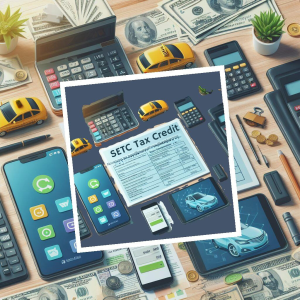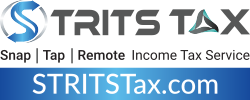SETC Tax Credit Overview: Navigating Tax Benefits for Self-Employed Taxi Services (Uber, Lyft, Curb)

Summary:
Self-employed individuals in the taxi services sector, including those driving for platforms like Uber, Lyft, and Curb, can unlock valuable tax benefits through the Self-Employment Tax Credit (SETC). This comprehensive guide delves into the intricacies of the SETC, outlining eligibility criteria, qualified amounts, and strategic approaches for maximizing tax savings.
Detail Explanation:
Understanding the SETC:
The Self-Employment Tax Credit (SETC) is a tailored tax incentive designed to alleviate the tax burdens of self-employed individuals, especially those in the taxi services industry. As independent contractors, Uber, Lyft, and Curb drivers qualify for this credit, offering them a strategic tool for optimizing their tax liabilities.
Eligibility Criteria:
To harness the benefits of the SETC, self-employed taxi service providers must meet specific eligibility criteria. Generally, this includes being an independent contractor or freelancer in the transportation sector, actively driving for platforms like Uber, Lyft, or Curb, and filing taxes as a self-employed individual.
Qualified Sick and Family Leave Equivalent Amounts:
The SETC encompasses qualified sick and family leave equivalent amounts, providing relief for self-employed individuals facing challenges related to COVID-19. Under the FFCRA, eligible individuals can claim a refundable tax credit against their income tax liability. The qualified sick leave equivalent amount is calculated based on factors such as quarantine orders, COVID-19 symptoms, or caring for someone affected.
Claiming the Tax Credit:
Self-employed taxi service providers can claim the SETC by reporting the qualified sick and family leave equivalent amounts on their tax return for the relevant year. Timely and accurate documentation is crucial for a successful claim, and the IRS provides guidelines on the necessary paperwork to support these claims.
Strategic Approaches for Maximizing Benefits:
To optimize tax savings, self-employed taxi service providers should adopt strategic approaches. This may involve meticulous record-keeping of income, expenses, and COVID-19-related circumstances. Leveraging accounting software or seeking professional assistance can streamline the process and ensure accurate submissions.
Pros and Cons:
| Pros | Cons |
|---|---|
| Eases tax burdens for self-employed taxi drivers | Eligibility criteria must be met |
| Refundable tax credits provide financial relief | Application and documentation can be complex |
| Addresses specific challenges related to COVID-19 | Limited time frame for claiming credits |
Tips for the Reader 📘:
Enhance your tax strategy by maintaining detailed records of income, expenses, and COVID-19-related circumstances. Leverage professional assistance for accurate submissions and stay informed about timelines to maximize benefits. 🚗📊
Follow our Social Media for more information:
We will need to file an amendment on your tax return. All we require from you is a copy of your 2019, 2020 and 2021 tax returns and a copy of your driver's license, and we’ll handle the rest.
The Sick and Family Leave tax credit for self-employed and 1099 workers is for eligible self-employed individuals or independent contractors. Under the FFCRA, eligible self-employed individuals or independent contractors could claim a refundable tax credit against their income tax liability for up to 100% of the qualified sick and family leave equivalent amounts.
The qualified sick leave equivalent amount was the lesser of either $511 per day or 100% of the average daily self-employment income for each day an individual was unable to work or telework due to COVID-19-related reasons. The qualified family leave equivalent amount was the lesser of either $200 per day or 67% of the average daily self-employment income for each day an individual was unable to work or telework because they needed to care for a child whose school or place of care was closed due to COVID-19.
To claim the tax credit, eligible self-employed individuals or independent contractors would report the qualified sick and family leave equivalent amounts on their 2019, 2020, or 2021 tax return, depending on when the leave was taken.
For the most part, all we require is your 2019, 2020, and 2021 tax return, including your schedule C, and a copy of your driver's license for identification.
Our fee schedule is really simple. This is to cover our costs for filling out all the paperwork and securing your refund from the IRS. Then once you receive your refund from the IRS, an additional 20% of your refund amount is then due AFTER you receive your refund. That’s it! No small print or hidden charges whatsoever.
Not at all. We basically have an agreement letter on our website that you’ll need to read, sign, and date. You will also need to upload a copy of your 2019, 2020, and 2021 tax returns and a copy of your driver's license. That’s basically it. We try to make the process as easy and stress-free as we can for you. Once we have your tax returns, we’ll take over and get everything filed for you.
Yes. This tax credit is for self-employed individuals, small business owners, freelancers, and 1099 contractors only.
There are a few factors that go into calculating your tax credit refund amount. The biggest factors would be your net income from your schedule C on your 2019, 2020, and 2021 tax returns, how many days you were out sick or told to quarantine with Covid-19, how long you might have cared for a loved one affected by Covid-19, and how long any schools or daycare centers were closed (and you were forced to care for a minor child during the closings).
To be honest, once we receive the necessary paperwork from you, we will begin to work on your case and get all the forms filed, etc. It is then up to the IRS to send you your refund directly to you. We find for the most part that it usually takes 12-16 weeks to complete the process and receive your cash refund.
Yes, you can email TaxHelp@STRITSTax.com.

